Solar Power - the most abundant energy source in the world

Solar Fast Facts
Enough solar energy hits the earth in one hour to power the entire planet for a year.
Solar photovoltaic (PV) cells convert solar radiation into a usable form of energy: electricity (the term "photovoltaic" cells refers to semiconducting cells, known commonly as "solar cells"). PV power entails harnessing the sun's energy to directly produce electricity by converting sunlight into electricity through solar cells (the "photovoltaic effect").
A solar panel is comprised of many solar cells, and a solar array is comprised of many solar panels.
The basic building block of the solar cell has commonly been silicon, an element found in sand (these are known as crystalline silicon solar cells). Traditionally, solar cells are combinations of silicon and other organic materials, glass, and metal; which are manufactured to create solar PV panels.
Different forms of the traditional silicon cell, such as amorphous silicon, and nanocrystalline silicon, are being used in flexible, thin-film solar arrays in production and use today.
However, in modern advanced thin-film solar arrays, silicon is sometimes replaced with other semiconductor materials; such as cadmium telluride and copper gallium (among others).
Even graphene has found a use in cutting-edge solar cell production (in solar cells that are still in R&D, with limited commercial availability).
These innovations in solar cell design are all developed to increase the efficiency of the conductivity of the cells, and decrease the cost of production of solar cells. PV panels are combined into what is known as PV arrays for - buildings, properties, home rooftops, community solar/ microgrids, and large-scale (utility-scale) solar farms.
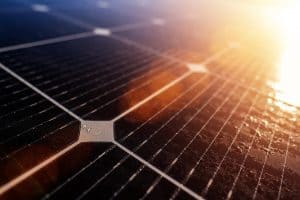 A key advancement in the design of the modern solar cell is the production of more efficient solar cells using less expensive, and readily available materials.
A key advancement in the design of the modern solar cell is the production of more efficient solar cells using less expensive, and readily available materials.
There have been recent breakthroughs in solar PV technology that have dropped the cost and increased the efficiency of solar cells - most significantly, with nano-PV panels and thin-film solar arrays. Nano-PV solar cells result in much more cost-efficient, compact, thinner, and more energy-efficient, solar panels.
Nanotechnologies in PV with from 4 to 7 times (or more) the efficiency of standard photovoltaic cells are currently being developed and implemented in all forms of commercial solar PV. The most efficient solar PV farms use utility-scale thin-film PV solar panel arrays.
There are nano, thin-film, and alternative material PV cells currently in R&D, and commercially available versions, with substantially higher efficiency than the standard silicon solar PV cell. Solar cells many times more efficient than even the most efficient commercially available solar cells are in limited beta-testing phases (see: engineers-just-created-the-most-efficient-solar-cells-ever, and mit.edu/new-solar-cell-more-efficient-costs-less).
The solar arrays being produced today are exponentially improved with the continued research, development, refinement, and implementation of nanotechnology.
Please read: Breakthroughs in Solar
Solar Rooftop and Community Solar; Net Metering
At the residential, business, or community level, (advanced) crystalline silicon is still the norm for most solar rooftop PV and other small PV arrays for a property. PV using alternative, advanced materials, and nano-PV, is gaining ground for use in solar rooftop PV.
Here is a basic illustration of how a solar rooftop PV system works (with a home battery for storing excess electricity, and also using a net metering system):

1- rooftop photovoltaic array 2- home battery (optional home energy storage) 3- energy converter to produce usable electricity for the home and battery from the solar energy 4- municipal grid (the home can sometimes send energy generated from its solar PV panels to the grid, in addition to continuing to receive electricity from the grid, see the passages on net metering below)
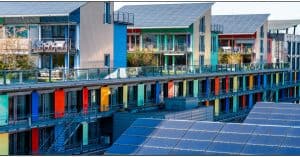
The most readily accessible form of solar power for most people is solar rooftop PV or PV arrays within a convenient location somewhere on a property. Solar PV panels are becoming increasingly more affordable for property owners.
Rooftop solar PV is exemplified in the small town of Vauban, Germany, where rooftop PV is ubiquitous. Another world standout for rooftop PV includes homes and businesses in Australia, where over 1/4 of properties have rooftop PV or PV arrays.
In addition to solar PV for homes and businesses, community solar projects (and other solar microgrids) are also increasingly available throughout some cities; as exemplified by the city of Austin, Texas. There is an article in Green City Times that discusses community solar that also describes net metering.
Net metering programs are where homes/ buildings with rooftop solar PV panels, or PV panel arrays on a property, provide excess energy back to the energy grid, lowering the energy bill of the building (*limited to cities and states where net metering is available). Also aiding the growing use of solar PV are incentives, rebates, and subsidies for solar PV (*in cities and states where government subsidies are available; and/ or in cities and states where rebates from manufacturers and retailers are available).
Utility-scale Solar and Solar Thermal
Large-scale (utility-scale) solar farms are created using arrays of thin-film PV panels, and also with crystalline PV panel arrays. Utility-scale solar farms can also be created using a couple of types of solar thermal technologies; such as concentrated solar power (CSP), and more mobile, smaller units of solar thermal energy such as dishes and troughs (parabolic solar).
Solar water heaters can use solar PV, solar thermal technologies, or a hybrid mix of solar technologies. Solar power, in all of its various forms, represents a consistently productive and continuously promising source of renewable energy. By combining solar energy with energy storage, the amount of energy that solar can provide is increased exponentially. Solar PV technology is consistently getting more efficient and less expensive.
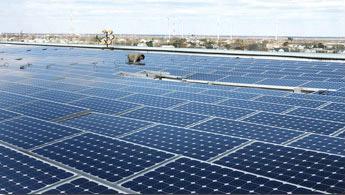
An example of a large, successful, utility-scale solar photovoltaic farm using high-efficiency solar cell technology in the U.S. is the Topaz solar farm. Breakthroughs in solar cell technology are bringing the cost of utility-scale solar to a lower cost than fossil fuels. This is evidenced by Topaz, and throughout the global utility-scale solar industry in new solar projects of all sizes throughout the world.
Solar PV continues to be a viable and constantly improving energy source to power the grid for most of the United States (in addition to other renewable energy sources, and non-renewable energy sources like natural gas and nuclear).
Another key development in solar energy is the trend in the utility-scale solar industry of using natural gas and energy storage to augment solar energy production, which is intermittent and depends on the sun being out, or solar rays being able to get through the earth's atmosphere to hit the solar cells.
In addition to advancements in traditional PV technology and storage of solar energy, there have also been exponential advancements in the field of solar thermal energy. Instead of simply converting energy from the sun into electricity, with solar thermal technology, solar energy heats a working fluid to produce steam.
The liquid in solar thermal systems could be water, H2O + molten salt, or another working fluid, and then the steam produced in the process is used to drive generators. Solar thermal represents an advancement in solar energy with 4 to 5 times the power density of PV.
Reductions in the cost of solar thermal technology have been difficult to realize, however, solar water heaters and concentrated solar power (CSP) plants are successful commercial applications of solar thermal energy technologies. In addition to solar water heaters and CSP, successful commercial solar thermal generation technologies include parabolic solar projects.
One commercially successful application of solar power is the solar-powered water heater. Solar-powered water heaters are mandatory in new construction in the state of Hawaii, and are similarly installed in all new construction in the country of Israel, as well as a few other countries and localities.
Some of the other applications of solar thermal energy include hot water and heating for homes, RVs, large appliances; and even in remotely situated buildings...in industrial buildings, schools, hospitals, etc...
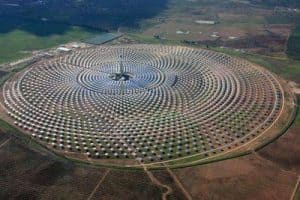
The most promising new technologies in the world of utility-scale solar power are CSP solar plants. Concentrated Solar Power (CSP) is a technology that uses a large array of lenses and mirrors (heliostats) to focus sunlight onto PV cells set as a receiver on a central tower. An example of a large CSP plant is the Gemasolar Concentrated Solar Power Plant in Seville, Spain, and another is the Ivanpah Solar Plant in the Mojave desert.
CSP plants/ farms, also known as concentrated solar thermal farms, use mirrors (heliostats) to focus sunlight onto a small receiver on a tower in the center of the array. CSP plants produce power by first focusing sunlight from the heliostats onto a concentrated group of solar cells arranged as an installation on a tower.
Then, the CSP plant uses that heat energy to heat up a working fluid (like molten salt, oil, and/or water), creating steam, which drives a turbine to create electricity.
Great examples of CSP plants are found in Spain, Italy, Australia, and Mexico, as well as the US states of California, Arizona, Colorado, New Mexico, Utah, and Nevada (just to mention a few locales for this emerging technology).
Also used for various power supply needs, and/ or in conjunction with CSP plants, are solar dishes and solar troughs. Solar dishes and troughs focus sunlight to heat a working fluid (such as molten salt, synthetic oil, and/or water). Dishes and troughs hold great promise for the future of renewable energy.
Dishes and troughs (parabolic solar) are often used in applications like solar water heating, or on a stand-alone basis to power buildings, RVs, or large appliances. Parabolic solar facilities can also send power to a municipal grid. Solar dishes and troughs work by focusing sunlight onto a group of PVs, or working fluid, or both, near the source.
CSP plants first focus light on PV cells, then use that captured energy to heat a working fluid, while solar dishes and troughs harness solar energy to heat a working fluid piped just above the dish or trough. Then, this high-temperature fluid is used to heat water, creating steam to spin a turbine or to power an engine that drives a generator, creating electricity.
Here's a basic illustration of a simple parabolic solar installation:
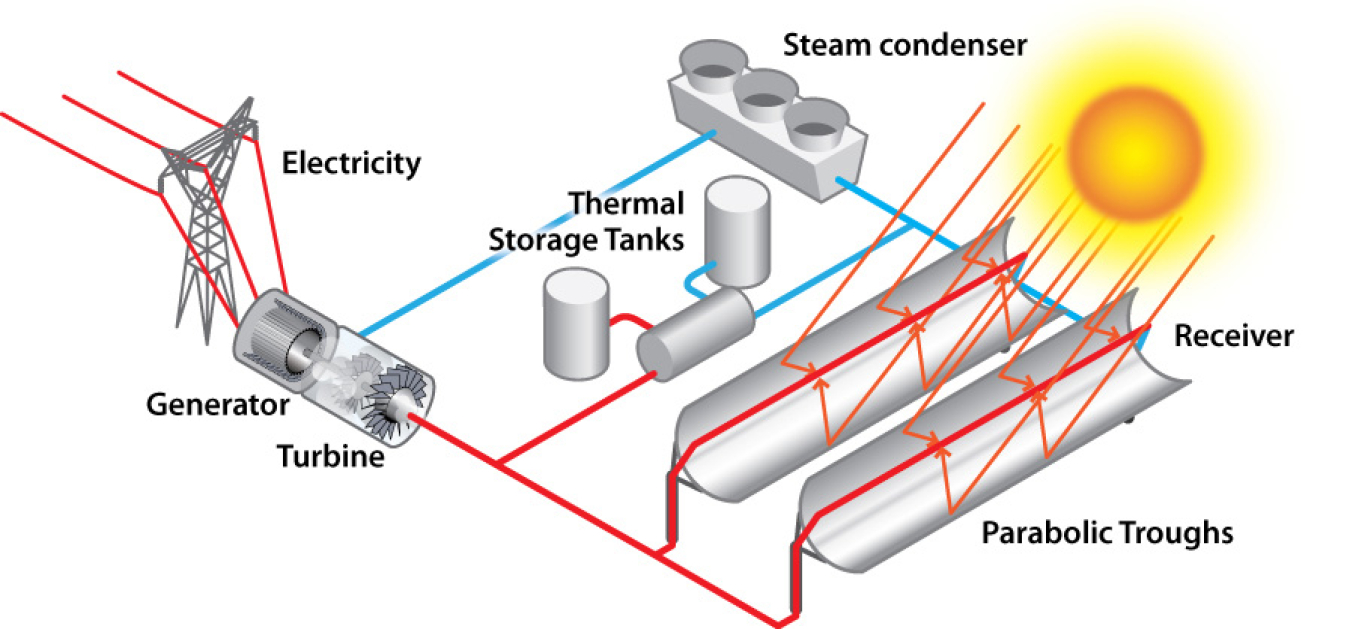
Both types of solar energy (PV and solar thermal) will continue to steadily lessen in cost as technological advancements are made.
However, photovoltaic is projected to remain ahead of thermal in terms of cost of production and therefore, deployment and utilization. Solar thermal technologies do have a couple of advantages that compensate for the higher cost. Solar thermal energy is produced consistently throughout the day, not relying on weather conditions.
The turbines for solar thermal installations will run on natural gas if there is no sun for an extended period of time. Solar thermal units integrate easily with power storage systems (as technically solar storage systems themselves are a type of energy storage).
Solar thermal systems will continue to produce energy at night, using energy harnessed during the day.
Please click & read:
Recent breakthroughs in solar photovoltaic and solar thermal technologies
Community solar and net metering - pushing renewable energy forward
Ivanpah Solar Electric Generating System
The 550-megawatt Topaz Solar Plant